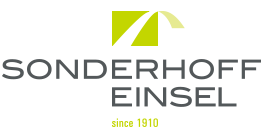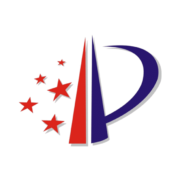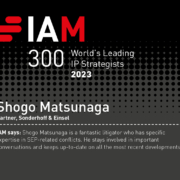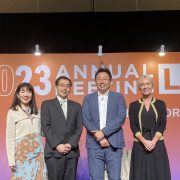Explanation of the main Points of the Amended Implementing Regulations of the Patent Law of the People’s Republic of China
On December 21, 2023, the Decision of the State Council on the Amendment of the Implementing Regulations of the Patent Law of the People’s Republic of China (hereinafter referred to as the “Amended Implementing Regulations”) was published by Decree No. 769 of the State Council. According to the decision, the Amended Implementing Regulations corresponding to the Patent Law of the People’s Republic of China (hereinafter referred to as the “Amended Patent Law”), which came into force on June 1st 2021, will officially come into force on January 20th 2024 after a long period of revision work.
The amendments, which include many important changes, are of great significance to patent affairs. This article, as a preliminary report, explains the main amendments to the amended Implementing Regulations in five parts: Patent application, Examination of Patents, Protection of Patent Rights, Enforcement of Patents, and Harmonization with International Rules.
I. Patent application
1.Clarification of provisions for the delivery of documents in electronic form
Rule 4 of the Amended Implementing Regulations stipulates the submission and delivery of documents in electronic form. In practice, the estimated date of delivery of a document in electronic form is the date of issuance of the document plus 15 days as the date of delivery by mail. After the amendment, the addition of 15 days will be abolished, and the date of delivery of a document sent in electronic form by the State Intellectual Property Office will be the date of delivery on the date of entry into the electronic system recognized by the parties. That is, the date of delivery is likely to be the same day as the date of publication of the document.
2.Clarification of document requirements for partial design application
The partial design system falls under a new provision introduced when the Patent Law was amended. Rule 30 and 31 of the amended Implementing Rules stipulate that the documents to be submitted for a partial design application shall be submit as before, such as the submission of an overall view of the product, and the part to be protected shall be indicated by a combination of dotted lines and solid lines or other methods.
3. Relaxation of the Exception for Loss of Novelty
According to Rule 33 of the Amended Implementation Regulations, the scope of “academic or technical conferences” has been expanded to include “academic or technical conferences by international organizations recognized by the relevant competent departments of the State Council” with regards to the exception for loss of novelty. It is highly likely that international organizations, such as the IEEE (Institute of Electrical and Electronics Engineers) in the field of telecommunications, and meetings held by the like will be included in the scope of the exception of loss of novelty exception. In addition, the amendment relaxes the requirements for submission of documents showing prior publication at an international exhibition or conference, and eliminates the need to submit documents issued by the organizer of the relevant international exhibition or conference and stipulates that it is only necessary to submit documents proving that the invention have been exhibited or published at an international exhibition or conference. For example, it is assumed that it will be possible to prove it by submitting flyers for exhibitions, brochures for conferences, booklets, etc.
4. Enhancement of the priority system
Rule 36 of the Amended Implementation Regulations introduced a system for reinstating rights after the expiry of the priority period and a system for correction of priority rights after filing an application for inventions and utility models. Prior to the amendment, an application filed after the expiration of the priority period could not claim priority, but after the amendment, a request for restoration of the priority right can be made if two months have not elapsed since the expiration date of the priority period, that is, if 14 months have not elapsed from the priority date.
In addition, Rule 128 of the amended Implementation Regulations stipulates that if the PCT receiving Office reinstates the priority of a PCT application, the State Intellectual Property Office shall recognize the restoration procedure when the PCT application moves to the domestic stage in China. If a request for restoration of priority has not been made at the international stage, or if the receiving Office has not approved the request for restoration of priority, the applicant may request restoration of priority within two months after the PCT application moves to the domestic stage in China.
In addition, with regards to the correction of the right of priority for inventions and utility models, if there is an omission or mistake in the right of priority, the applicant may request the addition or correction of the claim of priority within 16 months from the date of priority or within 4 months from the date of filing (whichever is later).
5. Relaxation of Patent affairs by Overseas Companies
The pre-amendment provision that foreign companies that do not have an address or place of business in China must delegate to a patent agency when processing patent applications and other patent affairs in China was amended to allow them to handle some patent affairs on their own according to Rule 18 of the Amended Implementation Regulations, such as the submission of a copy of the first-application document and the payment of expenses when claiming priority rights, without delegating to the patent agency.
II. Examination of Patents
1. Regulation of irregular applications
In line with the principle of good faith stipulated in Article 20 of the amended Patent Law, Rule 11 of the Amended Implementation Regulations clarified that patent applications should follow the principle of good faith and that when filing a patent application, it must be based on actual invention and creation activities and must not include any false information. Rule 11 of the Amended Implementation Regulations is not only a reason for refusal in formal examinations and substantive examinations, but also reasons for invalidation trials. In the patent field, there is no end to the number of irregular applications that have become a problem. The main purpose of these irregular applications is to defraud subsidies by taking advantage of loopholes in government policies, such as patent filing grants and tax incentives for high-tech companies. Since 2017, there have been regulations on the conduct of irregular applications, such as “some provisions to regulate the conduct of filing”, but since there is a legislative gap, Rule 100 of the Amended Implementation Regulations can fill the gap by giving the patent law enforcement department the authority to issue warnings and impose fines on applicants for non-normal applications.
2. Introduction of Examination of Obvious Inventive Step of Utility Models and Designs
According to Rule 50 of the Amended Implementation Regulations, the scope of examination of utility models is no longer limited to novelty and practicality, but has been expanded to include Article 22 of the Patent Law, namely, novelty, inventive step and practicality, and the requirement that the examination of a design must have a clear difference compared to conventional design or the combination of conventional design features. The amendment makes it legal to reject utility models on the lack of inventive step (as to designs, they are not easy to be created), which has already been done in practice. In the future, it is expected that the registration rate of utility models and designs will be further reduced.
3. Adjustment of the confidentiality review system
According to Rule 9 of the Amended Implementation Regulations, the deadline for issuing a notice of examination and the deadline for issuing an examination decision for a request for confidentiality examination for an invention created in China to be filed in foreign countries, respectively have been shortened from 4 months and 6 months to 2 months and 4 months, respectively, and can be extended by 2 months in complex cases. It also stipulates that the State Intellectual Property Office will no longer be able to conduct a confidentiality examination with an implied permission and will have to make a clear decision on whether to approve the applicant’s request for a confidentiality examination.
4. Introduction of the delayed examination system
In 2023, the National Intellectual Property Office promulgated Guidelines on Delayed Examination of Invention Patent Applications, which has introduced a delayed examination system for invention patent applications. Rule 56, Paragraph 2 of the Amended Implementation Regulations confirms the system from the legislative side and clarifies for the first time that an applicant can request a delayed examination of patent and utility model and design applications. The delayed examination system allows the applicant to appropriately amend the scope of a claim in accordance with the latest technology and changes in market competition, or to decide whether to withdraw the application according to the market situation of the product.
5. Remedies for delay of the time limit for a request for reexamination
The time limit for requesting restoration of rights is stipulated to be within two months from the date of receipt of the notice of loss of rights. However, the reality is that even if the period for requesting a reexamination has expired, a notice of loss of rights will not be issued. In practice, it is possible to remedy the loss of rights by requesting restoration of rights only within two months from the date of the expiration of the period for requesting a reexamination. Accordingly, Rule 6 of the Amended Implementation Regulations has been amended to provide that in accordance with the relevant practice, a request for restoration of rights can be made only within two months from the date on which the period for requesting reexamination expires.
6. Adjustment of pre-examination provisions and expansion of the scope of examination in reexamination
With the deletion of the provision on that the request for reexamination to be pre-examined by the original examination department in the Amended Implementation Regulations, it is now possible to conduct a pre-examination of the reexamination by a person other than the examiner who issued the decision of refusal and the department to which the examiner belongs.
In addition, the scope of examination includes not only the content of the request for reexamination, but also whether there are circumstances in which the patent application violates the provisions of the Patent Law and the Amended Implementation Regulations. In other words, the scope of examination is not limited to the reasons pointed out in the decision of refusal, but also includes all matters that violate the provisions of the amended Patent Law and the amended Implementation Regulations. A decision of reexamination against the applicant may maintain a refusal based on the reasons of the original decision of refusal or may maintain a refusal based on reasons introduced ex officio or on other reasons not in the decision of refusal.
III. Protection of Patent Rights
1. Introduction of a system for extending the term of patent rights
Rule 42 of the amended Patent Law stipulates that the term of a patent right shall be extended in the event of an unreasonable delay in the examination process of an invention patent and an extension of the term of the patent for the approval of a new drug in National Medical Products Administration. The amendment to the Implementation Regulations adds specific provisions for the operation of these two types of extensions.
In accordance with Rules 77~79 of the Amended Implementation Regulations, with regard to the extension of the duration for unreasonable delay in the examination process, the number of days of extension shall be the actual number of days unreasonably delayed in the examination process refers to the number of days between the date of filing for a patent for invention for four years and the date of three years from the date of request for substantive examination to the date of announcement of the grant of the patent right, minus the number of days of reasonable delay and the number of days of unreasonable delay caused by the applicant.
Examples of reasonable delays include 1) delays caused by the reexamination procedure in the case of registration due to amendments made in the reexamination proceedings, and 2) delays caused by the discontinuation of proceedings due to disputes over the attribution of rights or property preservation.
Examples of unreasonable delays by the applicant include 1) failure to respond to the notice of reasons for refusal within the specified period, and 2) filing of a request for delayed examination.
In addition, relevant provisions have been established regarding the extension of the term of a new drug from the approval period.
According to Rule 80 of the Amended Implementation Regulations, patents for inventions related to new drugs refer to patents for new drug products, manufacturing methods, and medical use.
According to Rule 81 of the Amended Implementation Regulations, there are three requirements for extension: (1) if more than one patent exists for the new drug at the same time, the patentee may request an extension of the term of the patent only for any one of the patents; (2) if a patent relates to more than one new drug at the same time, an extension of the term of the patent of the patent may be requested for only one new drug; (3) the patent is within the validity period, and the patent period has not been extended for the invention related to the new drug.
According to Rule 82 of the Amended Implementation Regulations, the extension period shall be determined of the interval between the filing date of the application and the date of approving of the new drug in China minus 5 years. It shall be determined of complying with the provisions of Article 42, Paragraph 3 of the amended Patent Law, which is the extension period shall not exceed 5 years and total validity period after the approval of the new drug shall not exceed 14 years.
2. Establishment of Patent Dispute Resolution and Mediation System
In accordance with the provision in Article 70, Paragraph 1 of the amended Patent Law that “the State Intellectual Property Office may, at the request of a patent holder or an interested party, handle a patent infringement dispute that has a significant impact on the whole country”, Rule 96 of the Amended Implementation Regulations clarifies the category of “has a significant impact on the whole country” as follows. Particularly, it can be seen from item (4) that discretionary power is given to the State Intellectual Property Office:
(1) Situations related to significant public interest
(2) Situations that have a significant impact on the development of industry
(3) Serious matters that span provinces, autonomous regions, and municipalities under direct jurisdiction
(4) Circumstances in which the Patent Administration Department of the State Council has determined that there is a possibility of significant impact.
IV. Enforcement of Patents
1. Optimization of relevant provisions of the patent evaluation report
Rule 62 of the Amended Implementation Regulations has been amended to expand the scope of requests for patent evaluation reports from patentees and interested parties to patentees, interested parties, and alleged infringers, and to allow requests to be made not only after the announcement but also at the time of registration.
2. Establishment of an open license system
In line with the introduction of the open license system in the amended Patent Law, the specific operation of the open license system is stipulated in Rule 85 ~ 88 of the Amended Implementation Regulations. When making an open license statement, it is required to specify the patent number, the name or designation of the patentee, the basis and payment method of the license fee, the license period, etc. If a patent license is agreed upon through an open license, a document proving that the agreement to the license has been agreed to must be submitted to the Patent Administration Department of the State Council. A patentee may be given a warning by the patent law enforcement department or fined up to 100,000 yuan for abusing the open license system to obtain a reduction in patent pensions, providing false information or concealing facts.
3. Enhancement of the incentive and remuneration system for employee inventions
Rules 92~94 of the Amended Implementation Regulations stipulates the amount of incentives for employee inventions, the method of encouragement, and the method of determining remuneration for implementation. The minimum amount of incentives has been increased from 3,000 yuan to 4,000 yuan for patents and from 1,000 yuan to 1,500 yuan for utility models and designs. In the absence of an agreement between the parties regarding remuneration for implementation, it is stipulated that remuneration shall be given to the inventor in a reasonable manner in accordance with the provisions of the Law on the Promotion of the Utilization of Scientific and Technological Results of the People’s Republic of China.
V. Harmonization with International Rules
1. Provisional protection for PCT applications
Article 13 of the amended Patent Law provides for a provisional protection system for invention patent applications, and appropriately protects the applicant from publication to registration. According to the Implementation Regulations before the amendment, the term ” publication” as defined in Article 13 of the amended Patent Law refers to the international publication with respect to PCT applications published in Chinese at the international stage. Even in this case, if the date of international publication is taken as the starting date of the provisional protection period, the applicant will be disadvantaged, so the “date of publication” has been amended from “the date of international publication” to “the date of international publication or the date of publication by the Patent Administration Department of the State Council” in accordance with Rule 132 of the Amended Implementation Regulations.
2. The Hague Convention on Designs
In conjunction with China’s official accession to the Hague Agreement on the International Registration of the designs of Industrial Products on May 5, 2022, special provisions have been added to the requirements for international applications, procedures, examinations, determination of filing dates, and submission of priority rights for filing designs through the Hague Agreement route. The amendment will meet the diverse needs of design in terms of the system and will also help China better fulfill its international obligations.
As mentioned above, the main points of the Amended Implementation Regulations have been explained, but this revision is in accordance with the amended Patent Law, and further detailed application is stipulated in the Amended Examination guideline. It will be necessary to pay more attention to how it will affect practice in the future.
USPTO to begin issuing certificates of correction electronically beginning on January 30, 2024
Beginning on January 30, 2024, the USPTO will start issuing certificates of correction in a paperless, electronic format. The electronically issued certificates of correction will be immediately available to view online using the USPTO Patent Center upon the issuance of the patent itself. Electronic certificates of correction will be issued regardless of whether the patent has already issued electronically, or in paper format.
Until January 30, 2024, certificates of correction will continue to be issued in paper format and mailed via post to the correspondence address on record for the patent. After the paper certificate of correction is issued, a scanned image of the paper certificate of correction is entered into the file wrapper and added to the image of the patent in the patent database. Additionally, the patent number corresponding to the certificate of correction is published in the Official Gazette.
If you have any questions regarding certificates of correction, please do not hesitate to contact our office.
USPTO: Notice of upcoming DOCX filing fee date of January 17, 2024
The USPTO recently announced its intention to move forward with the implementation of the $400 USD fee for filing specifications and claims in non-DOCX format on January 17, 2024. While it may be possible that the USPTO will extend the deadline again, it appears more likely than not that the USPTO will not extend this deadline any further.
This filing fee applies to all non-provisional applications and continuing applications, but it is important to note that this fee does not apply to drawings, national stage applications, design applications, and provisional applications, which can still be filed in PDF format without incurring the surcharge.
If your organization has not made a decision about whether or not to transition to filing in the DOCX format, we encourage you to make a decision soon in order to prepare for the implementation of the non-DOCX filing fee.
If you have any questions or require more information, please do not hesitate to contact our office.
Shogo Matsunaga’s comments were featured in an article in “mlex”, which is published by Lexis Nexis.
Sonderhoff & Einsel Law and Patent Office
Shin Marunouchi Center Bldg. 18th Floor
1-6-2 Marunouchi, Chiyoda-ku
Tokyo 100-0005
Tel +81-3-5220-6500
Fax +81-3-5220-6556 (G3)
Fax +81-3-5220-6583 (Law Department)
Contact us by Email
General inquiries info@se1910.com
Inquiries regarding Patents & Utility Models patent@se1910.com
Inquiries regarding Trademarks trademark@se1910.com
Inquiries regarding Designs trademark@se1910.com
Inquiries regarding Legal matters isaji@se1910.com
Sonderhoff & Einsel Tax Co.
Shin Marunouchi Center Bldg. 18th Floor
1-6-2 Marunouchi, Chiyoda-ku
Tokyo 100-0005
Tel +81-3-5220-6563
Fax +81-3-5220-6564
Email tax@se1910.com
S&E CPA Office, Tokyo
Shin Marunouchi Center Bldg. 18th Floor
1-6-2 Marunouchi, Chiyoda-ku
Tokyo 100-0005
Tel +81-3-5220-6504
Fax +81-3-5220-6580
Email audit@se1910.com










